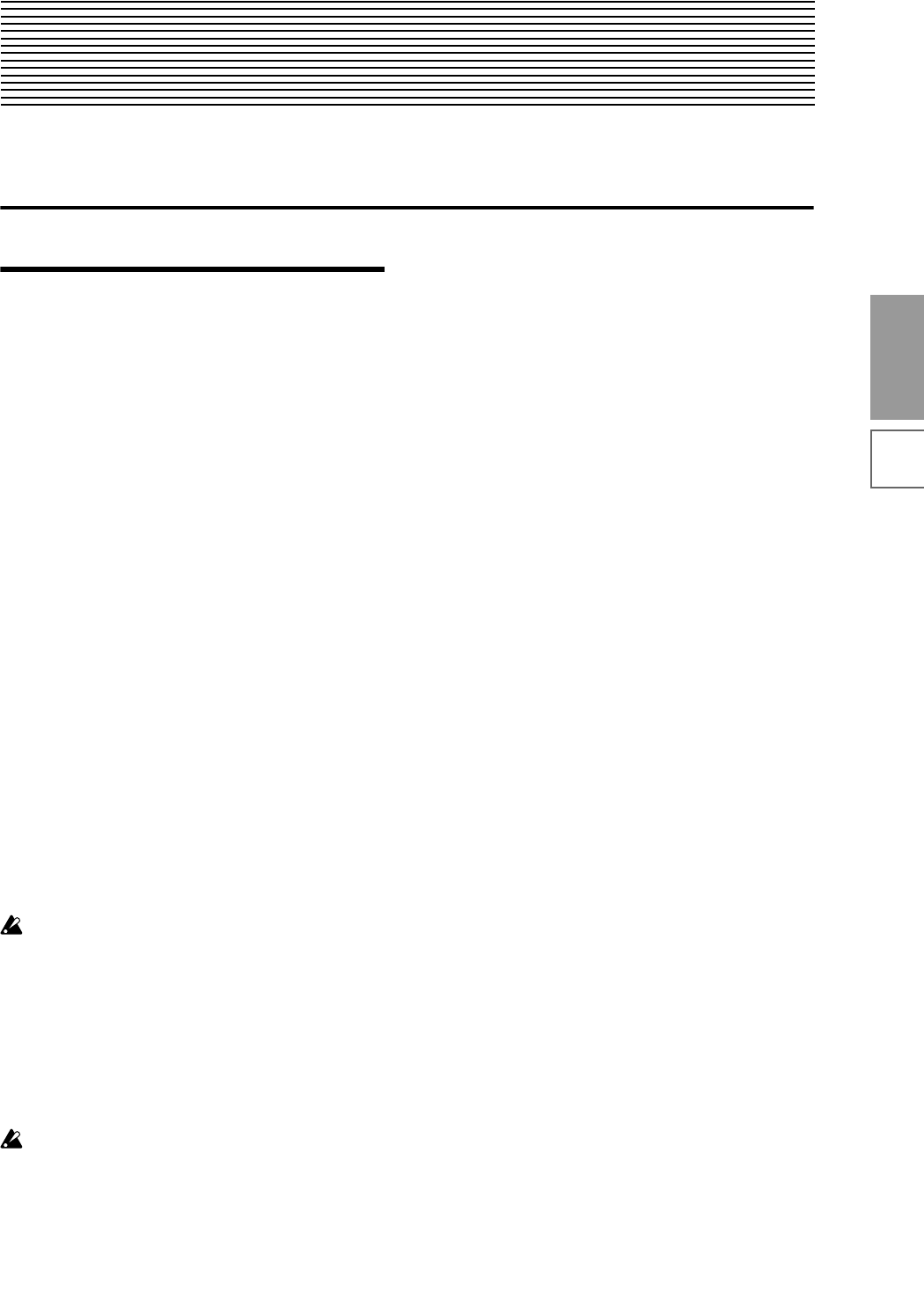
Basic functions
Saving dataLoading dataProgram
settings
Combination
settings
Producing
songs
Sampling
settings
Creating a
CD
SMF
playback
System
settings
Drum kit
settings
Arpeggiator
settings
Effects
settings
Other
functions
55
Basic functions
Saving data
Types of data that can be saved
On the TRITON STUDIO, there are three ways to save
data: writing to internal memory, saving on media
(floppy disk, internal hard drive, CD-R/RW, hard disk
and other removable media etc.), and MIDI data dump.
Writing to internal memory
The following types of edited can be written into the inter-
nal memory.
• Program
Programs 0–127 in banks INT-A–INT-F, EXB-A–EXB-G
(However, bank INT-F is available only if the EXB-
MOSS option is installed.)
• Combination
Combinations 0–127 in banks INT-A–INT-E, EXB-A–
EXB-G
• Global settings
(Global P0: Basic Setup–P4: Category Name)
• User drum kits 00 (I-A/B)–143 (User)
• User arpeggio patterns U000 (I-A/B)–U506 (User)
• User template songs U00–U15
Song settings such as the song name and tempo, track
settings (☞p.81), arpeggiator settings, and effect set-
tings can be saved (written) to internal memory. How-
ever, the musical data for song tracks and patterns are
not saved to internal memory. Furthermore, settings
that govern how the musical data is played back such
as “Meter,” “Metronome,” “Play/Mute,” “Track Play
Loop (including Start/End measure),” and RPPR set-
tings will not be saved either. Use the Sequencer mode
page menu command “Save Template Song” to write
this data (☞PG p.54).
If multisamples or samples from the RAM bank are
used in the Multisample or Drum Kit of a program,
you should be aware that these multisamples or sam-
ples cannot be written into memory. This means that
if you turn the power of and then on once again, pro-
grams or combinations that use such multisamples or
samples will not sound as intended. To reproduce
such programs or combinations, the necessary multi-
samples or samples must be saved on media (such as
floppy disk, hard disk, CD-R/RW and removable
disk etc.), and then reloaded.
Data that you edit in Sequencer, Song Play, or Sam-
pling cannot be saved in internal memory by the
Write operation.
Saving to various types of media
The following data can be saved to various types of
media.
• .PCG file:
Programs, combinations, global settings, user drum
kits, user arpeggio patterns (The data that was checked
in the check boxes of the Save dialog box will be
saved.)
• .SNG file: Song and cue list data
• .KSC, .KMP, .KSF files:
Lists of sample and multisamples (.KSC file), multi-
samples (.KMP file), samples (.KSF file).
• .MID file:
Saves a Sequencer mode song in Standard MIDI File
(SMF) format.
• .EXL file:
System exclusive data from an external device that was
saved on the TRITON STUDIO (This allows the TRI-
TON STUDIO to be used as a data filer.)
• .JKB file:
Jukebox lists are saved in Song Play mode (☞p.122).
All other types of file are saved in Disk mode.
• .WAV and .AIF files:
A sample you recorded can be exported (written) as a
WAVE file or AIFF file.
• .KCD file:
Audio track list
MIDI data dump
The following types of data can be transmitted as a MIDI
data dump and saved on an external data filer or other
device.
• Programs, combinations, global settings, user drum
kits, and user arpeggio patterns
• Songs, cue lists


















